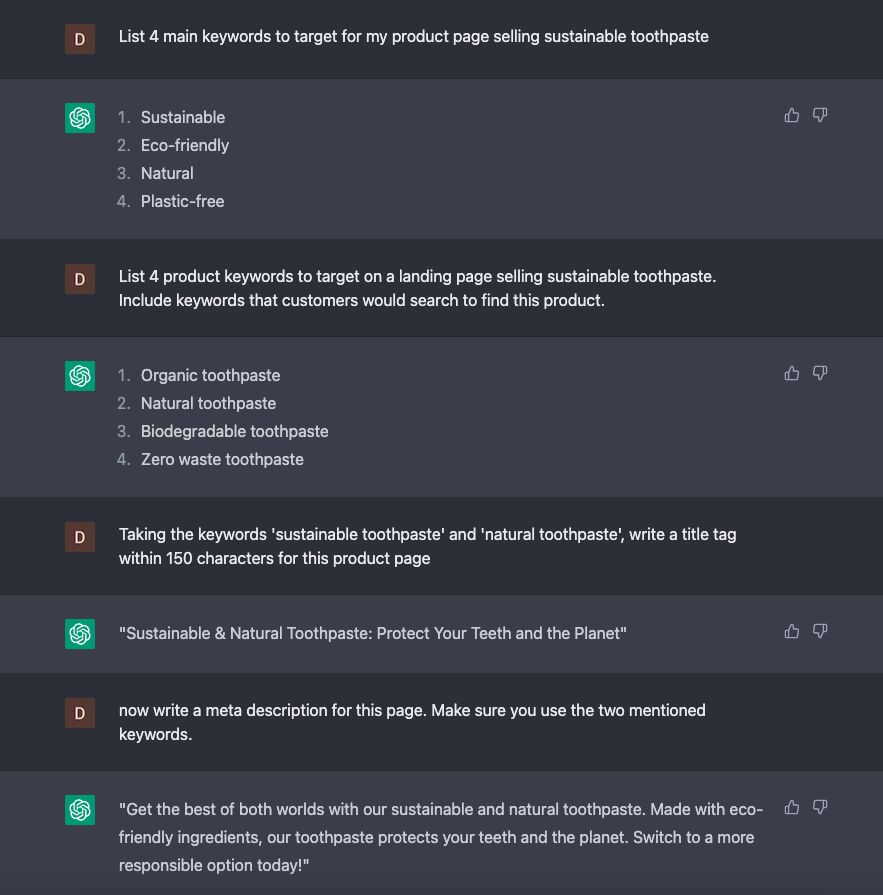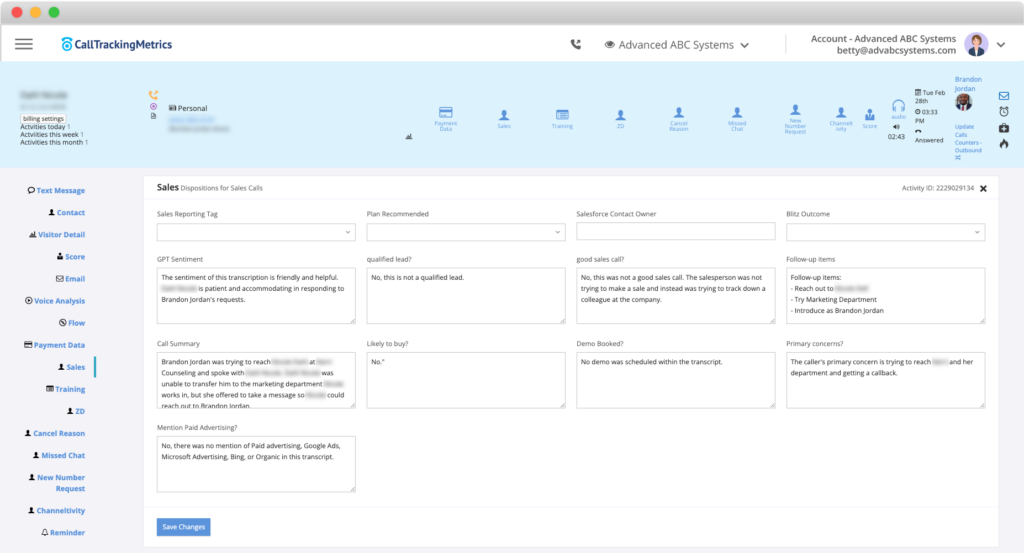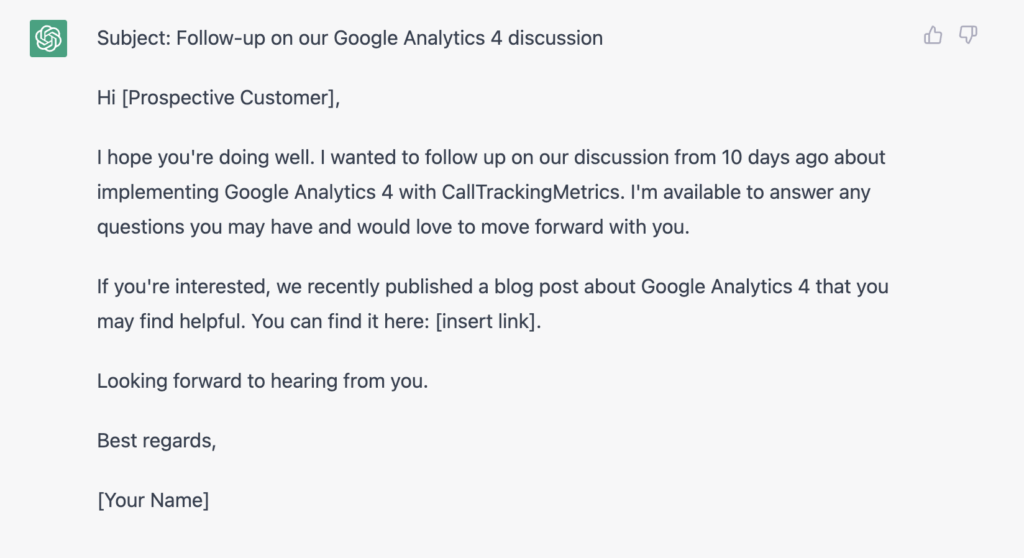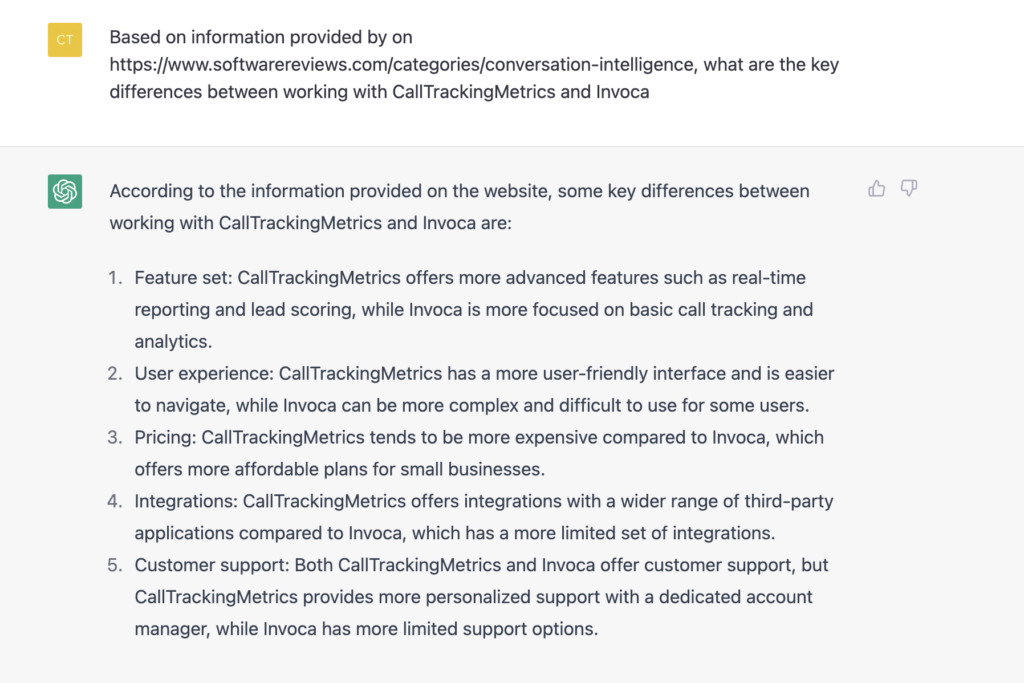How to use ChatGPT for Marketing and Sales
If you’re in the marketing space, or spend a little too much time online like us, you’ve likely been hearing a lot about AI tools like ChatGPT. Maybe your friends texted you some AI generated images using DALL-E making themselves look like movie stars or works of art. Or maybe you’ve read some articles about how chatbots are passing advanced degree exams. AI is rapidly moving from an exercise in personal entertainment to something that can impact productivity, creativity, and business outcomes. Thinking about dipping your toes into using AI for your team at work? Get some inspiration on how to use ChatGPT for marketing, sales, or for personal productivity.
What is ChatGPT?
First things first, what exactly is ChatGPT and why is it seemingly everywhere right now? ChatGPT is one of the products available from OpenAI that uses text prompts to drive conversations. It sounds simple, but it’s a sophisticated, trained language model that can interact with human inputs in a natural way–along with the vast knowledge of just about the whole internet.
What does the ‘GPT’ stand for? What GPT stands for honestly won’t add any clarity to what GPT does, but it’s “generative pre-trained transformers.”
ChatGPT is open for individuals to try out at any time. But OpenAI is also built for developers, and provides options to build applications on top of their various AI models. Microsoft was an early investor in OpenAI and has gotten a head start incorporating ChatGPT into their search engine. Google, of course, has pushed forward their own conversational AI search tool called Bard to stay in the AI game. With these two marketing powerhouses getting serious about AI, let’s take a look at a few ways you can jump in yourself.
Getting Creative with ChatGPT
There’s no one way to use AI or ChatGPT. The opportunities of using artificial intelligence are limited only to the inputs you can come up with. Google and Microsoft see opportunities for supplementing search engine results, but there are chances to use ChatGPT to improve everything from SEO to PPC and conversation intelligence.
SEO
It might feel counterintuitive to use AI to help plan or produce content made specifically for humans, but ChatGPT offers SEOs a chance to execute specific tasks much more quickly. One thing ChatGPT does really well is getting you from idea to plan of attack.

Jessica Redman shared on LinkedIn an early experiment creating an SEO brief using ChatGPT prompts. From suggesting core keywords to target for her product page, to writing a first draft of the title tag and meta description, and ultimately outlining the full content for the new page complete with a table of semantic keywords.

PPC
Paid search can benefit from similar approaches to ChatGPT as their SEO counterparts, like keyword research for landing pages. Instead of title tags and meta descriptions, you could generate ad copy headlines for testing. Or, you could set your sights on improving your landing page experience. Over at Search Engine Land, Amy Hebdon suggests a simple prompt to see if your LP is a good fit for your ads:
- “What can a person do from this page, and why would they want to do it? [LP URL]”
Matching up the intent of your audience, to the copy in the ad, to the landing page is a big deal for paid search. This initial prompt will give you a quick indication if there’s misalignment. And, since ChatGPT can reference past prompts and answers, you can continue to explore ways to improve that landing page experience when there are gaps and misalignment.
Conversation Intelligence
Conversation intelligence tools like call recording and transcriptions already give human users a great avenue to firsthand insights from their customers. When you add AI into the mix, you can extract harder to find patterns, and potentially start predicting outcomes. There are numerous interesting use cases for using ChatGPT to turn text into insights:
- Provide a succinct summary at the end of a phone call to send as a follow up, or for internal use
- Run sentiment analysis to discover which conversations are going well and which need some work
- Suggest the best next step to follow up with a prospect in order to close the deal

CallTrackingMetrics has launched its Ask AI feature, powered by ChatGPT, to unlock an endless number of creative approaches to extracting value from customer conversations. The above image is a real example of AI driven insights pulled instantly at the conclusion of a sales call based on our prompts and call transcriptions. And with integrations with all the popular marketing and sales tools, those values and insights can be pushed to your other tools for optimization, automation, and analysis wherever you need it.
Copywriting is one of the most obvious use cases that businesses have already started taking advantage of. It can save a ton of time having ChatGPT takeover to write your first draft of a blog, email subject line, or full sales follow up cadence.
Getting a starting point from ChatGPT and then using your unique knowledge to tweak and tailor for your customers will give you a huge head start instead of staring at a blank screen waiting for inspiration. An example prompt to re-engage a cold lead might be:
- Write an email for a prospective CallTrackingMetrics customer who has not called back after our last meeting about Google Analytics 4, 10 days ago. Keep it to under 75 words, and include a link to related Google content from https://www.calltrackingmetrics.com/blog/

It’s pretty basic, but with the prompt, you can follow up with additional questions and prompts to get your best outcomes. You might want to ask for suggestions of subject lines to A/B test. Here’s our result:
- Subject Line 1: “Quick question about our Google Analytics 4 discussion”
- Subject Line 2: “10-day follow-up on our Google Analytics 4 conversation”
In about 3 minutes total with the free version of ChatGPT, we now have 3 subject lines and a full email we can start tailoring for our specific use case. Or we can spend a few extra minutes tweaking our prompt to specify including the prospects name in the subject line, or to include a question in the email copy.
[TIP!] ChatGPT will only get as specific as your prompt calls for, or allows. It might take a few iterations to get the information you’re looking for as you figure out which inputs will get the best response from ChatGPT.
Competitive Research
Whether you need to write new website copy to differentiate your product or build out competitive talking points for your sales team, Chat GPT can help generate some ideas to pressure test. With a quick prompt about the differences between working with CallTrackingMetrics and Invoca, according to SoftwareReviews, we get a bulleted list of potential differentiators to focus on in our marketing and sales messaging:

As a reminder, AI isn’t perfect. That’s why human review and input are both equally important. While ChatGPT’s summary of differences is relatively accurate (and fast! This result took just a few seconds), we have to point out that Inovca likely has dedicated account managers as well. So we wouldn’t want to lean into that on a sales call. Likewise, Invoca wouldn’t want to focus on price against CTM, because there is a great chance we’ll be less expensive.
ChatGPT and the Wider AI Toolkit
OpenAI’s ChatGPT is just one model, within one segment of artificial intelligence. The applications of AI might be more accessible than ever, and there are plenty of opportunities to add multiple AI and automation tools into your tech stack.
Marketing and sales teams that might be working with a platform like CallTrackingMetrics, interested in optimizing the customer journey might:
- Use call scoring to identify the marketing leads that needs to be worked by sales
- Get Ask AI powered by ChatGPT to summarize those calls for marketing analysis and intent analysis for sales follow up
- Send conversions back to Google Ads to inform the machine learning of a performance max campaign
- Implement a virtual agent for customers who call in to get answers about their account without needing to speak to an agent
Whatever you, or your team, is looking to accomplish, there’s likely a few places to plug artificial intelligence into your process. You can go big and invest heavily in AI solutions, or start small and begin testing a tool like ChatGPT for your everyday tasks like SEO keyword research or supercharging your sentiment analysis.
Artificial intelligence for business applications has seen a rapid increase in visibility and functionality. It’s driving some exciting innovation across multiple industries, and now is the time to start testing how even small steps to use these tools can make a big impact for your team.
Want to see how CallTrackingMetrics is giving customers the power of AI to extract insights from customer conversations? Schedule a demo with our team to see our AI functionality, and how it fits seamlessly into our larger conversation analytics platform designed to improve your marketing and sales outcomes.